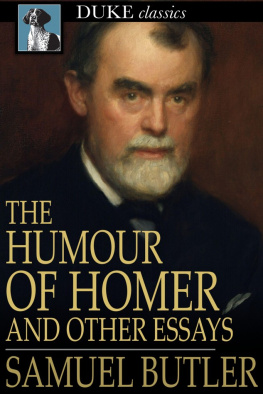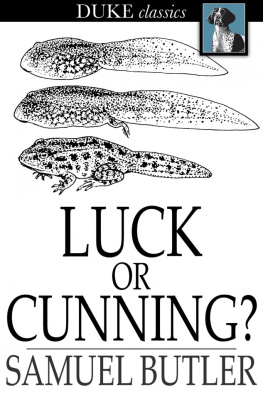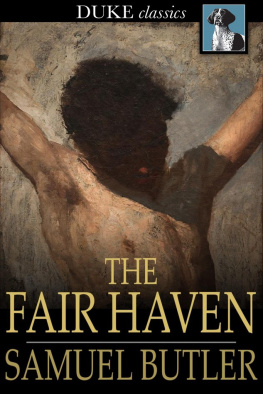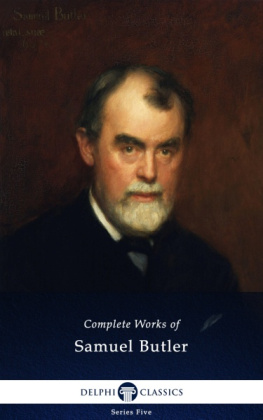THE HUMOUR OF HOMER
AND OTHER ESSAYS
* * *
SAMUEL BUTLER
Edited by
R. A. STREATFIELD
*
The Humour of Homer
And Other Essays
First published in 1913
ISBN 978-1-62012-065-1
Duke Classics
2012 Duke Classics and its licensors. All rights reserved.
While every effort has been used to ensure the accuracy and reliability of the information contained in this edition, Duke Classics does not assume liability or responsibility for any errors or omissions in this book. Duke Classics does not accept responsibility for loss suffered as a result of reliance upon the accuracy or currency of information contained in this book.
Contents
*
Introduction
*
The nucleus of this book is the collection of essays by SamuelButler, which was originally published by Mr. Grant Richards in 1904under the title Essays on Life, Art and Science, and reissued by Mr.Fifield in 1908. To these are now added another essay, entitled"The Humour of Homer," a biographical sketch of the author kindlycontributed by Mr. Henry Festing Jones, which will add materially tothe value of the edition, and a portrait in photogravure from aphotograph taken in 1889the period of the essays.
"The Humour of Homer" was originally delivered as a lecture at theWorking Men's College in Great Ormond Street on the 30th January,1892, the day on which Butler first promulgated his theory of theTrapanese origin of the Odyssey in a letter to the Athenaeum. Laterin the same year it was published with some additional matter byMessrs. Metcalfe and Co. of Cambridge. For the next five yearsButler was engaged upon researches into the origin and authorship ofthe Odyssey, the results of which are embodied in his book TheAuthoress of the "Odyssey," originally published by Messrs. Longmanin 1897. Butler incorporated a good deal of "The Humour of Homer"into The Authoress of the "Odyssey," but the section relating to theIliad naturally found no place in the later work. For the sake ofthis alone "The Humour of Homer" deserves to be better known.Written as it was for an artisan audience and professing to dealonly with one side of Homer's genius, "The Humour of Homer" mustnot, of course, be taken as an exhaustive statement of Butler'sviews upon Homeric questions. It touches but lightly on importantpoints, particularly regarding the origin and authorship of theOdyssey, which are treated at much greater length in The Authoressof the "Odyssey."
Nevertheless, "The Humour of Homer" appears to me to have a specialvalue as a kind of general introduction to Butler's more detailedstudy of the Odyssey. His attitude towards the Homeric poems ishere expressed with extraordinary freshness and force. What thatattitude was is best explained by his own words: "If a person wouldunderstand either the Odyssey or any other ancient work, he mustnever look at the dead without seeing the living in them, nor at theliving without thinking of the dead. We are too fond of seeing theancients as one thing and the moderns as another." Butler did notundervalue the philological and archaeological importance of theIliad and the Odyssey, but it was mainly as human documents thatthey appealed to him. This, I am inclined to suspect, was the rootof the objection of academic critics to him and his theories. Theydid not so much resent the suggestion that the author of the Odysseywas a woman; they could not endure that he should be treated as ahuman being.
Of the remaining essays two were originally delivered as lectures;the others appeared first in The Universal Review in 1888, 1889 and1890. I should perhaps explain why two other essays which alsoappeared in The Universal Review are not included in thiscollection. The first of these, entitled "L'Affaire Holbein-Rippel," relates to a drawing of Holbein's "Danse des Paysans" inthe Basle Museum, which is usually described as a copy, but whichButler believed to be the work of Holbein himself. This essayrequires to be illustrated in so elaborate a manner that it wasimpossible to include it in a book of this size. The second essay,which is a sketch of the career of the sculptor Tabachetti, waspublished as the first section of an article, entitled "A Sculptorand a Shrine," of which the second part is here given under thetitle "The Sanctuary of Montrigone." The section devoted to thesculptor contains all that Butler then knew about Tabachetti, butsince it was written various documents have come to light,principally through the investigations of Cavaliere Francesco Negri,of Casale Monferrato, which negative some of Butler's conclusions.Had Butler lived, I do not doubt that he would have revised hisessay in the light of Cavaliere Negri's discoveries, the value ofwhich he fully recognized. As it stands the essay requires so muchrevision that I have decided to omit it altogether and to postponegiving English readers a full account of Tabachetti's career until asecond edition of Butler's "Ex Voto," in which Tabachetti's work isdiscussed in detail, is required. Meanwhile I have given a briefsummary of the main facts of Tabachetti's life in a note (p. 195) tothe essay on "Art in the Valley of Saas." Anyone who desiresfurther details concerning the sculptor and his work will find themin Cavaliere Negri's pamphlet "Il Santuario di Crea" (Alessandria,1902).
The three essays grouped together under the title The Deadlock inDarwinism may be regarded as a postscript to Butler's four books onevolution, viz. Life and Habit, Evolution Old and New, UnconsciousMemory, and Luck or Cunning? When these essays were first publishedin book form in 1904, I ventured to give a brief summary of Butler'sposition with regard to the main problem of evolution. I need nowonly refer readers to Mr. Festing Jones's biographical sketch and,for fuller details, to the masterly introduction contributed byProfessor Marcus Hartog to the new edition of Unconscious Memory (A.C. Fifield, 1910), and recently reprinted in his Problems of Lifeand Reproduction (John Murray, 1913), in which Butler's work in thefield of biology and his share in the various controversiesconnected with the study of evolution are discussed with theauthority of a specialist.
R. A. STREATFEILD. July, 1913.
Sketch of the Life of Samuel Butler
*
Author of Erewhon
(1835-1902)
By Henry Festing Jones
Note
This sketch of Butler's life, together with the portrait which formsthe frontispiece to this volume, first appeared in December, 1902,in The Eagle, the magazine of St. John's College, Cambridge. Irevised the sketch and read it before the British HomoeopathicAssociation at 43 Russell Square, London, W.C., on the 9th February,1910; some of Butler's music was performed by Miss Grainger Kerr,Mr. R. A. Streatfeild, Mr. J. A. Fuller Maitland, and Mr. H. J. T.Wood, the secretary of the Association. I again revised it and readit before the Historical Society of St. John's College, Cambridge,in the combination room of the college on the 16th November, 1910;the Master (Mr. R. F. Scott), who was also Vice-Chancellor of theUniversity, was in the chair, and a vote of thanks was proposed byProfessor William Bateson, F.R.S.
As the full Memoir of Butler on which I am engaged is not yet readyfor publication, I have again revised the sketch, and it is herepublished in response to many demands for some account of his life.
H. F. J.August, 1913.
Sketch of the Life of Samuel ButlerAuthor of Erewhon (1835-1902)
Samuel Butler was born on the 4th December, 1835, at the Rectory,Langar, near Bingham, in Nottinghamshire. His father was the Rev.Thomas Butler, then Rector of Langar, afterwards one of the canonsof Lincoln Cathedral, and his mother was Fanny Worsley, daughter ofJohn Philip Worsley of Arno's Vale, Bristol, sugar-refiner. Hisgrandfather was Dr. Samuel Butler, the famous headmaster ofShrewsbury School, afterwards Bishop of Lichfield. The Butlers arenot related either to the author of Hudibras, or to the author ofthe Analogy, or to the present Master of Trinity College, Cambridge.










